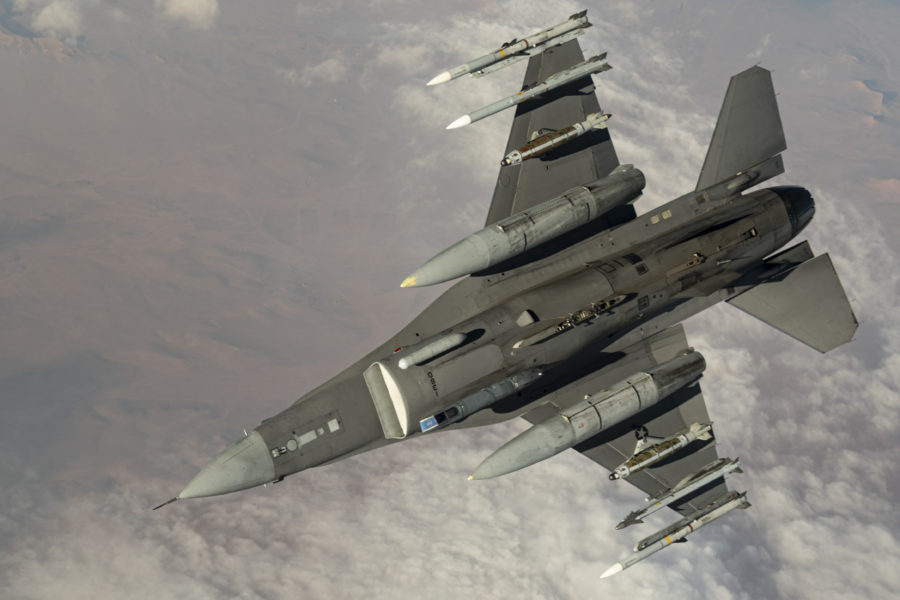A senior Department of Defense official provided the clearest explanation yet for why the U.S. has declined Ukraine’s requests to restock their air force with American-made fighters: It would take too long and cost too much.
Colin Kahl, undersecretary of defense for policy, said F-16s would cost too much, especially given how long it would take before Ukraine could use the aircraft in combat.
“We don’t see F-16s as the top priority right now,” Kahl testified Feb. 28 at a House Armed Services Committee hearing. Air defense, artillery and long-range precision fires, and armored vehicles and tanks are more important right now, Kahl said.
Providing F-16s could take three to six years for new aircraft and cost up to $11 billion to equip Ukraine, Kahl said. But he also acknowledged that older, used F-16s could be provided for as little as $2 billion, and fielded in as little as 18-24 months.
The cost is dependent on the number, age, and types of F-16s provided. Kahl said the long lead time on delivery negates any potential advantage of getting Ukrainian pilots into F-16 training right now, as they wouldn’t have planes to fly once they completed training.
“It is a priority for the Ukrainians,” Kahl said of Western aircraft. “But it’s not one of their top three priorities.”
In an interview broadcast Feb. 24, President Joe Biden said Ukraine “didn’t need” F-16s, at least for now. Biden discussed the matter with Ukraine President Volodymyr Zelenskyy face-to-face when he visited Kyiv earlier in February.
Kahl said Ukraine requested as many as 128 fourth-generation aircraft—a mix of F-15s, F/A-18s, and F-16s. But the U.S. holds a different view of what Ukraine needs right now. Kahl said over the longer term, Ukraine will likely get Western jets.
“Our Air Force estimates that over the long-term, Ukraine would probably need 50-80 F-16s to replace their existing air force,” Kahl said. Such a force would cost $10-11 billion, he added.
Lawmakers from both parties and both the House and Senate have called on the Biden administration to provide F-16s. In testimony, Kahl’s most extensive answers came in response to Rep. Chrissy Houlahan (D-Pa.), an Air Force veteran who signed a bipartisan letter supporting the provision of F-16s to Ukraine.
There is also opposition in the House. HASC Ranking Member Rep. Adam Smith (D-Wash.) agreed with Kahl, suggesting that pledging F-16s to Ukraine right now would not be the most prudent use of American resources.
The F-16 was designed and introduced more than four decades ago, but new versions are still in production. Now made by Lockheed Martin, the current Block 70/72 models in production first flew this past January and are far more advanced than other models, featuring AESA radars and high-tech targeting pods. Lockheed Martin says it has a backlog of 148 new jets on order, all for overseas customers.
Kahl said the U.S. could possibly offer Ukraine older Block 30/32 F-16s, but it is not clear where exactly those jets would come from. The Air Force has 935 F-16C and F-16D jets in its inventory, plus an additional 66 QF-16s, which are used as remotely piloted aerial targets.
If the U.S. halved the number of aircraft it thought Ukraine needed, to around 36 older models, that would still cost $2-$3 billion, Kahl said. A U.S. F-16 squadron is composed of around 24 aircraft.
Older F-16s could also be taken from the Air Force’s retired boneyard at Davis-Monahan Air Force Base, Ariz., but how long it would take to make any of those aircraft flyable is unknown. They are in varying condition and many have already been cannibalized for parts.
The Air Force is also loath to part with existing aircraft in its inventory, because its capacity is already stretched thin.
U.S. officials have sought to balance providing Ukraine with military capabilities without harming America’s own defense, which has been a particularly challenging issue with munitions supplies.
National Security Advisor Jake Sullivan said Feb. 26 that the U.S. was focused on augmenting Ukraine’s Soviet-designed air force, and that while Ukraine may eventually shift to Western aircraft, that was a question “for another time.”
Kahl left open the possibility that Ukraine could get other Western aircraft, such as British Tornadoes, Swedish Gripens, or French Mirages.
“It doesn’t make sense to start to train them on a system they may never get,” Kahl said.
The U.S. has provided Zuni rockets, Joint Direct Attack Munition (JDAM) guided bombs, and AGM-88 High-speed Anti-Radiation Missiles (HARM) to Ukraine, and helped enable its air force to launch those weapons.
In addition, U.S. defense and military officials said during multiple Congressional hearings Feb. 28 that unmanned aerial systems (UAS) were increasingly important. The U.S. pledged a number of new American UASs in February but has so far declined to provide long-range MQ-9s.
What the U.S. provides remains a topic of evolving choices and debate. “These are the tradeoffs we are making in real-time,” Kahl said.
